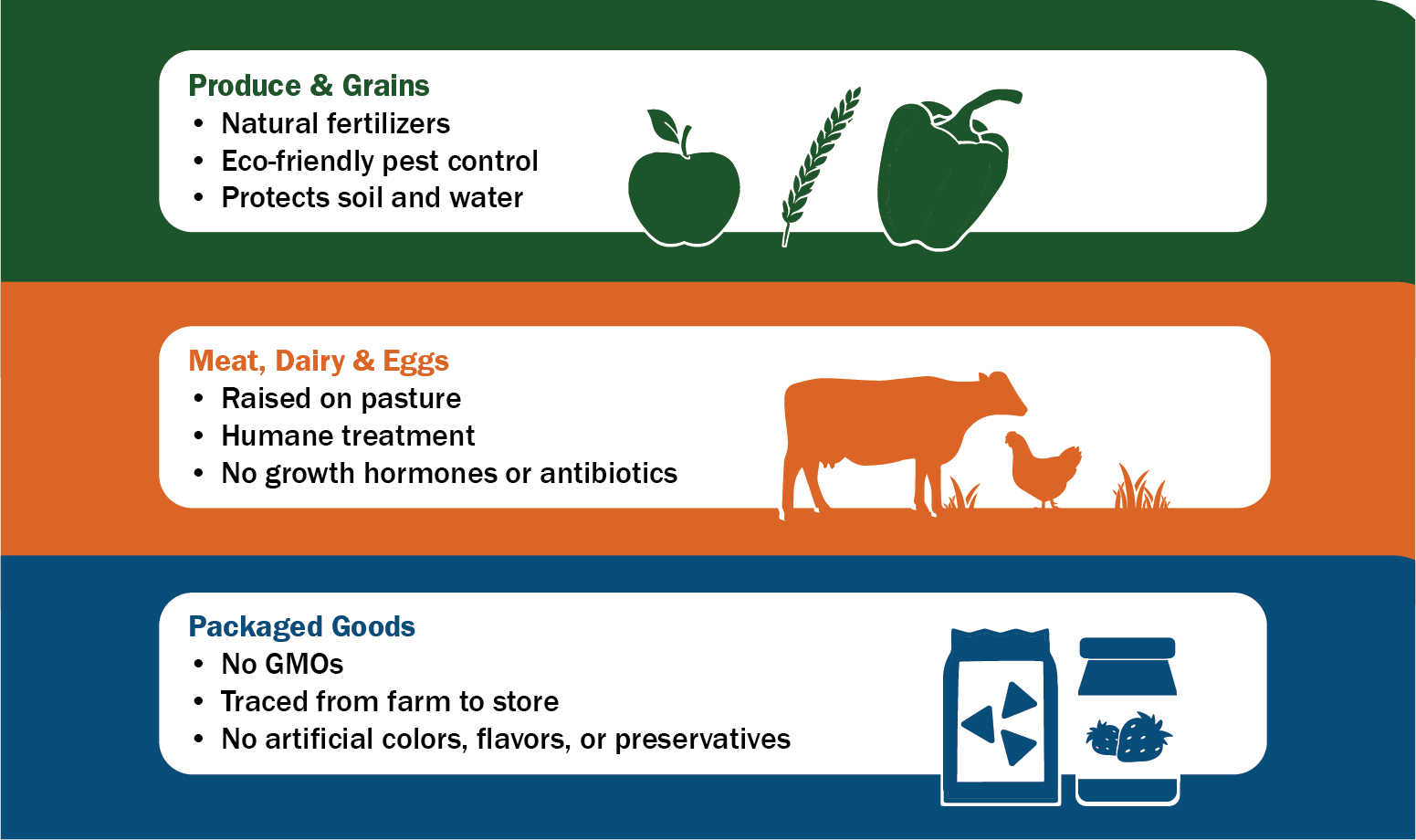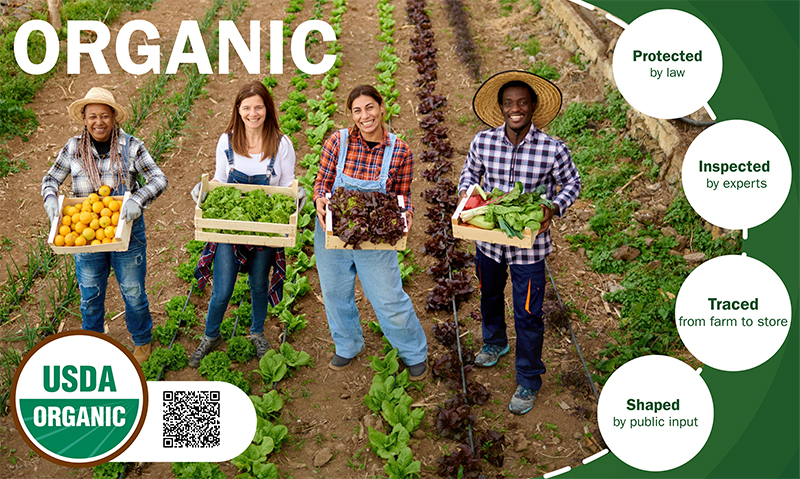by Kristina Kuhaupt, Customer Experience Manager
 Here at the Co-op we have sold many organic products since 1974 in all different departments—but why? Why do we prioritize this label when selecting goods to sell? It might seem like a buzzword to the wellness industry, but in fact, it has distinct rules, regulations, and thresholds intended to protect what we choose to consume through our nutritional food dollars. Many know that organic products, especially produce items, tend to cost more than conventional, but understanding more in-depth all the components working behind the scenes to protect what you eat might help ease concerns when potentially spending a bit more for an item.
Here at the Co-op we have sold many organic products since 1974 in all different departments—but why? Why do we prioritize this label when selecting goods to sell? It might seem like a buzzword to the wellness industry, but in fact, it has distinct rules, regulations, and thresholds intended to protect what we choose to consume through our nutritional food dollars. Many know that organic products, especially produce items, tend to cost more than conventional, but understanding more in-depth all the components working behind the scenes to protect what you eat might help ease concerns when potentially spending a bit more for an item.
All fresh produce, meat, dairy, packaged foods, beverages, textiles, fibers, leather, cosmetics, skincare, and personal products containing the USDA Organic seal are free from petroleum-based artificial fertilizers, pesticides, herbicides, genetic modifications, sewage sludge, irradiation, and genetically modified organisms. These products must have at least 95% certified organic content to be labeled as organic and use the USDA Organic seal. Products with at least 70% certified organic content can be labeled “made with” organic ingredients, but they cannot use the USDA Organic seal. If you are purchasing meat, you can be assured that the animals were fed organic feed without growth hormones. Additionally, there is a regulation requiring adequate proof of time outdoors and humane treatment. Not only during transportation but also in stores, organic products must be handled separately when transporting these goods so there is no cross-contamination.
Organic certification requires farmers to follow strict soil and water conservation practices, and producers must keep careful records showing that they follow these practices. Additionally, there is an inspection by a third-party certifier each and every year, which the farmer must pay for. Another reason why costs for organic items tend to be higher is because this farming practice does not use synthetic insecticides to manage pests; instead, these farmers tend to rely on insects and birds to help ward off diseases, which usually means 5–34% lower crop yield. Plus, produce can only be called organic if it’s certified to have grown on soil that had no prohibited substances applied for three years prior to harvest. Because of these practices, organic farming better helps combat greenhouse gas emissions, soil erosion, and water pollution compared to traditional farming. Additionally, organic practices actually can help store carbon in the soil and reduce greenhouse gas emissions. This in turn protects biodiversity, soil health, and water quality.
The rest of this article is intended to guide you through the four pillars of the USDA Organic label so that when you are shopping, you can determine the difference between one product and another. Before going into those specifics, let’s dive into the USDA’s National Organic Program in general.
The United States Department of Agriculture has something called the National Organic Program (NOP). According to USDA.gov, “NOP is a federal regulatory program that develops and enforces consistent national standards for organically produced agricultural products sold in the United States. NOP also accredits third-party organizations to certify that farms and businesses meet the national organic standards. These certifiers and USDA work together to enforce the standards, ensuring a level playing field for producers and protecting consumer confidence in the integrity of the USDA Organic Seal.” Within this program, they have a Strengthening Organic Enforcement rule that is in place to protect the integrity of the global organic supply chain. This is done through federal enforcement of the production, handling, and sale of organic goods.
The 4 Pillars: Protected, Inspected, Traced & Shaped
The USDA Organic label is protected by law, inspected by experts, traced from farm to store, and shaped by public input to solidify consumer trust.
Protected
This label is the only government-backed marketing claim for organic food sold in the United States. Only foods produced according to the USDA organic standards can display the organic seal, according to USDA.gov. To have this label on packaging, the product must meet organic standards of farming, production, and handling practices. The great thing about this label being trademarked is that it allows the USDA to enforce criminal penalties for those who would put this seal on fraudulent products. Additionally, this program investigates consumer complaints against potentially fraudulent products and conducts a thorough investigation so that you can feel safe in what you are purchasing.
Inspected
This program hires USDA-accredited organic farm certifiers who visit each business and farm every year to validate that they are continuously meeting the organic standards. Additionally, farms can expect surprise inspections from time to time.
Traced
Next, you can be sure that all certified organic items are traced from farm to store. In March of 2023, a new rule went into effect called The Strengthening Organic Enforcement Rule, which further strengthened the organic control systems by improving farm-to-market traceability and actively leaning into the enforcement of organic regulations. This was done to ensure continued consumer trust by detecting and shutting down fraud before it can even reach the store; this process uses an Integrity Database system to continuously monitor such operations.
Shaped
The final pillar is that the process of certified organic is continually shaped by public input. Public feedback is not only welcomed but encouraged! If you are an expert in this community, you can volunteer to serve on the National Organics Standards Board to give input and help that board advise policy. Lastly, both experts and the public are welcome to attend biannual National Organic Standards Board public meetings where your recommendations are taken into account. The next meeting is scheduled in Milwaukee from April 29-May 1st: https://www.ams.usda.gov/event/national-organic-standards-board-nosb-meeting-milwaukee-wi.
If you happen to be in the Portland, OR area in October, check out their meeting found at https://www.ams.usda.gov/event/national-organic-standards-board-nosb-meeting-portland-or.
We all have to prioritize stretching our food dollars, and it is acknowledged that organic can be more expensive in certain grocery categories than conventional products. No nutrition choice should ever be judged when making shopping decisions; however, I hope this article has given you some resources on what goes on behind the scenes when you see a certified organic label on the item you purchase and what that means for you when making food choices.
